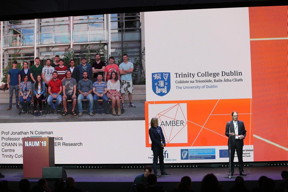Home > Press > The first nanotube applications award honors the scientist revolutionizing Li-ion batteries
 |
Abstract:
The first international award established for scientists developing industrial applications of single wall carbon nanotubes has announced its inaugural winner. The TUBALL Award has been presented to Prof. Jonathan Coleman from the AMBER Centre for his extensive work on carbon nanotubes, most recently on developing technology that increases the energy density of lithium-ion batteries by 2.5 times that of any existing battery on the market.
The first nanotube applications award honors the scientist revolutionizing Li-ion batteries
Luxembourg | Posted on December 17th, 2019Single wall carbon nanotubes (SWCNTs) are often called “the building material of the future” because of their ability to improve almost all materials around us. Thousands of researchers across the globe are working with SWCNTs and achieving impressive scientific results. The TUBALL Awards were established to help bring these breakthrough developments to life. These awards are the first to acknowledge R&D projects using SWCNTs across the whole range of their commercial applications.
The TUBALL Awards were initiated by OCSiAl, the world’s largest SWCNT manufacturer. Knowing the immense potential of SWCNTs to change materials, the company actively supports the transformation of the most promising projects from laboratory to industry. All scientists interested in project development with SWCNTs, irrespective of whether they also wish to apply to the award, are welcome to request a free sample of TUBALL nanotubes.
The first awardee, Prof. Jonathan Coleman from the AMBER Centre at Trinity College Dublin, collaborating with Nokia-Bell Labs Ireland and other AMBER researchers, developed the technology that uses TUBALL SWCNTs in the cathode and anode of a lithium-ion battery instead of the conventional additive carbon black. “Nanotubes in batteries are not just for conductivity. They are also for mechanics,” said Prof. Coleman. “This means that you have both very good electrical connection to the particles and also fantastic mechanical properties.” Thanks to these properties of SWCNTs, the research group was able to make the first-ever battery electrode that works at 100% of its theoretical capacity.
The results that Prof. Coleman and the AMBER/Nokia team have achieved in the laboratory pave the way to make batteries more compact, scalable for industry, quicker to charge and with 2.5 times more energy density than any battery currently on the market. This breakthrough can enable longer-lasting smartphones, mass electric vehicles, and home wind turbines with enough storage capacity.
The TUBALL Awards acknowledge the best SWCNT R&D projects once per year. The next round of applications starts from January 1, 2020, and will again give applicants an opportunity to win $10,000 for the development of their project. Any individual researcher or research group can participate and get TUBALL nanotubes for free. The award will be given to projects that are designed to significantly improve the properties of industrial materials and that contribute to the development of global industries.
####
For more information, please click here
Contacts:
Anastasia Zirka
PR & Advertising Manager
+7 913 989 9239
Copyright © OCSiAl Group
If you have a comment, please Contact us.Issuers of news releases, not 7th Wave, Inc. or Nanotechnology Now, are solely responsible for the accuracy of the content.
| Related Links |
| Related News Press |
News and information
![]() Simulating magnetization in a Heisenberg quantum spin chain April 5th, 2024
Simulating magnetization in a Heisenberg quantum spin chain April 5th, 2024
![]() NRL charters Navy’s quantum inertial navigation path to reduce drift April 5th, 2024
NRL charters Navy’s quantum inertial navigation path to reduce drift April 5th, 2024
![]() Discovery points path to flash-like memory for storing qubits: Rice find could hasten development of nonvolatile quantum memory April 5th, 2024
Discovery points path to flash-like memory for storing qubits: Rice find could hasten development of nonvolatile quantum memory April 5th, 2024
Nanotubes/Buckyballs/Fullerenes/Nanorods/Nanostrings
![]() Tests find no free-standing nanotubes released from tire tread wear September 8th, 2023
Tests find no free-standing nanotubes released from tire tread wear September 8th, 2023
![]() Detection of bacteria and viruses with fluorescent nanotubes July 21st, 2023
Detection of bacteria and viruses with fluorescent nanotubes July 21st, 2023
Materials/Metamaterials/Magnetoresistance
![]() Nanoscale CL thermometry with lanthanide-doped heavy-metal oxide in TEM March 8th, 2024
Nanoscale CL thermometry with lanthanide-doped heavy-metal oxide in TEM March 8th, 2024
![]() Focused ion beam technology: A single tool for a wide range of applications January 12th, 2024
Focused ion beam technology: A single tool for a wide range of applications January 12th, 2024
Announcements
![]() NRL charters Navy’s quantum inertial navigation path to reduce drift April 5th, 2024
NRL charters Navy’s quantum inertial navigation path to reduce drift April 5th, 2024
![]() Discovery points path to flash-like memory for storing qubits: Rice find could hasten development of nonvolatile quantum memory April 5th, 2024
Discovery points path to flash-like memory for storing qubits: Rice find could hasten development of nonvolatile quantum memory April 5th, 2024
Grants/Sponsored Research/Awards/Scholarships/Gifts/Contests/Honors/Records
![]() Discovery points path to flash-like memory for storing qubits: Rice find could hasten development of nonvolatile quantum memory April 5th, 2024
Discovery points path to flash-like memory for storing qubits: Rice find could hasten development of nonvolatile quantum memory April 5th, 2024
![]() Chemical reactions can scramble quantum information as well as black holes April 5th, 2024
Chemical reactions can scramble quantum information as well as black holes April 5th, 2024
|
|
||
|
|
||
| The latest news from around the world, FREE | ||
|
|
||
|
|
||
| Premium Products | ||
|
|
||
|
Only the news you want to read!
Learn More |
||
|
|
||
|
Full-service, expert consulting
Learn More |
||
|
|
||








